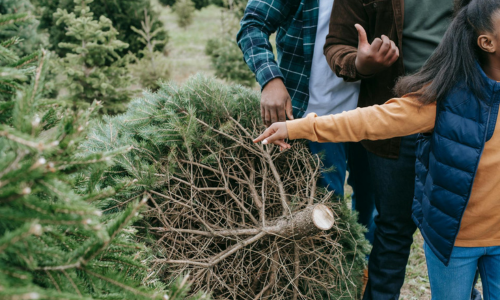This site may contain links to affiliate websites, and I may earn a commission for any purchases made through those links at no additional cost to you.

Choosing the Right Christmas Tree: A Comprehensive Guide
The holiday season has arrived, bringing with it the beloved tradition of finding the ideal Christmas tree.. Whether you’re a seasoned pro or a first-time buyer, this guide will help you navigate the process of finding a tree that’s beautiful, healthy, and suits your home perfectly. Let’s dive into the key factors to consider for making the best choice this Christmas.
Types of Christmas Trees: What Are Your Options?
1. Fir Trees
Fir trees rank among the most favored options for Christmas. Their strong branches, pleasant fragrance, and ability to hold ornaments make them ideal. Some popular fir varieties include:
-Fraser Fir: Renowned for its remarkable needle retention and deep green hue.
– Noble Fir: Praised for its sturdy branches and classic pyramid shape.
– Balsam Fir: Offers a delightful aroma and soft needles.
2. Pine Trees
If you’re looking for a traditional look, pine trees are a fantastic option. They have soft, long needles and are generally less prickly. Top picks include:
– White Pine: A soft, full tree with a delicate appearance.
– Scotch Pine: Renowned for its durability and needle retention.
3. Spruce Trees
Spruce trees are often chosen for their symmetrical appearance, but they may require more maintenance due to lower needle retention. Popular varieties include:
– Blue Spruce: Distinguished by its bluish-green needles.
– Norway Spruce: A lush tree with a traditional Christmas tree appearance.
How to Choose a Fresh Christmas Tree
Selecting a fresh tree ensures it lasts throughout the holiday season. Here’s how to identify a healthy tree:
1. Needles: Gently run your hand along the branches. Fresh needles should feel soft and stay attached to the tree.
2. Inspect the Color: Look for vibrant green foliage without brown or yellow patches.
3. Bend the Branches: Flexible branches indicate a freshly cut tree. Brittle branches suggest the tree is drying out.
4. Smell the Tree: A fresh tree should have a strong, natural scent.
Choosing the Right Size for Your Space
Measure Before You Buy
Ensure there is a clearance of at least 6-12 inches between the top of the tree and your ceiling to fit a tree topper comfortably.
-Account for the diameter of the tree stand.
Consider the Shape
Christmas trees come in various shapes, from slim to full. Opt for a slimmer tree for smaller spaces or a fuller tree if you have ample room to showcase it.
Live vs. Artificial Trees: Pros and Cons
Live Trees
Pros:
– Authentic fragrance and appearance.
– Eco-friendly when responsibly sourced.
– Supports local farmers.
Cons:
– Requires more maintenance (watering and cleaning fallen needles).
– Limited lifespan.
Artificial Trees
Pros:
– Reusable for multiple years.
– Available in pre-lit and customizable options.
– Less mess and maintenance.
Cons:
– Lacks the authentic scent of a live tree.
– Initial cost can be higher.
Tree Care Tips to Keep It Fresh
1. Cut the Trunk: Make a fresh cut about 1 inch from the bottom of the trunk to improve water absorption.
2. Use a Tree Stand with Water: Ensure the stand holds at least one gallon of water.
3. Check Water Levels Daily: Trees can drink up to a gallon of water per day.
4. Keep It Cool: Place your tree away from heat sources like fireplaces and radiators to prevent it from drying out.
Decorating Your Christmas Tree
Start with the Lights
– Use LED lights to reduce heat and save energy.
– Wrap lights from the base to the top, ensuring even coverage.
Add Garland and Ribbons
– Layer garlands evenly, starting from the top.
– Use wired ribbon for shaping and creating bows.
Hang Ornaments Last
– Place larger ornaments first to fill gaps.
– Balance smaller ornaments throughout the tree for an even look.
Disposing of Your Tree Responsibly
When the holidays are over, consider eco-friendly disposal options:
– Curbside Recycling: Many cities offer tree recycling programs.
– Mulching: Turn your tree into mulch for your garden.
– Wildlife Habitat: Place the tree in your yard as a shelter for birds.
Choosing the perfect Christmas tree is an art, but with the right knowledge, it can become a joyful part of your holiday traditions. From picking the right type to ensuring proper care and disposal, this guide equips you to make the best choice for your home and family.


You May Also Like

Financial Freedom 101: A Woman’s Guide to Building Wealth
July 26, 2024
Solo Travel: Embrace the Adventure and Stay Safe
August 22, 2024